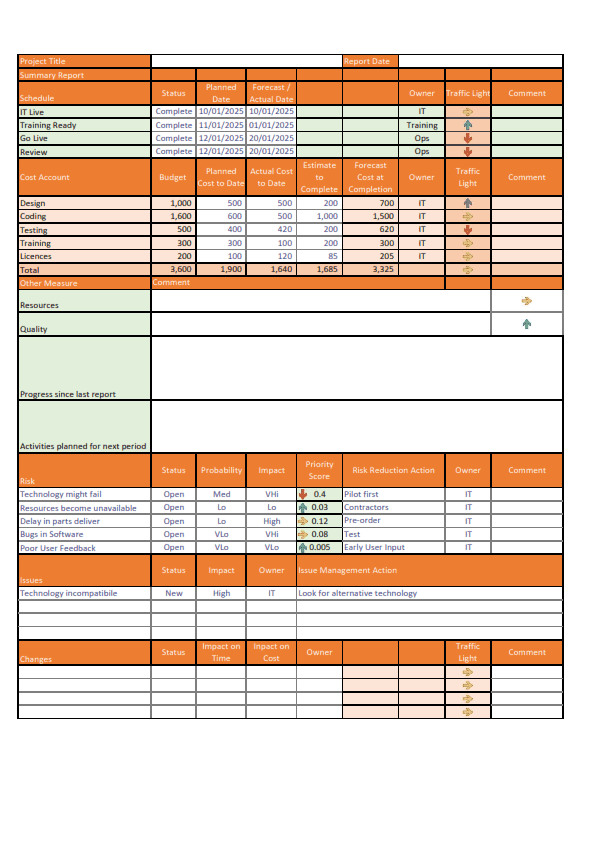Many projects and programmes use RAG status reporting but what are the advantages and disadvantages of using Red, Amber, Green reporting. Can we trust project and programme managers to be honest when using RAG reporting for their projects? What do we mean when a project has a red status? How should senior managers respond when a project flags a red status? In this post, we will explore the practicalities of using RAG status reporting for projects, including a template RAG status report to download for free.
What is RAG Status Reporting?
RAG status reporting is used when project managers are asked to indicate, how well a project is doing using the series traffic lights. A red traffic light indicates problems, amber everything is okay, green things going well. Some status reports just use one traffic light to indicate the overall project status, but typically project status report will include indicators the things such as performance against the budget, timescales, quality, and resources. Typically RAG status reports are used to summarise more qualitative data based on planned expenditure and the project schedule. The RAG reports give an instant indication to senior management of the project status and the need to intervene if the project is going out of control.
Why Use RAG Status Reporting?
RAG status reporting is extremely effective in a program or portfolio environment because it enables the organisation to create a summary report that consolidates all the status reports from a number of projects into one simple spreadsheet (download a template below). This can be used by the senior management in the organisation to quickly identify those projects which are in trouble and need support from the organisation to address weaknesses. The danger of this approach is that it relies on the project managers being confident enough to give genuine reports on project status. This raises a cultural issue about the way we use RAG status reports as part of a project management environment and the reactions of the organisation when a project manager sets the project to red. Everyone in the organisation needs a clear indication of what red means and then they need to behave in an appropriate way to address the underlying problems in the project not just “shoot the messenger“.
Rag Status Indicators and Actions
Ideally defining tolerances which can guide the selection of the appropriate rag status. These rag status indicators can be linked to the critical success criteria for the project. In this way, the organisation can get confidence that the rag status reports are based on more than just a subjective assessment of the project status. In the table below we define some typical RAG status indicators based on performance against time, cost, quality, resources and stakeholder satisfaction. Clearly these indicators will be different organisations because they have different sensitivities to overspends or delays in project delivery depending on the market the organisation serves.
The Disadvantage of RAG Reporting
One of the main disadvantages RAG reporting is lack of trust in the traffic lights reported by project managers. This stems from two factors first project managers may not have the confidence or the understanding of the project status to identify will project is heading to red. This may be because they lack information from the project control systems or there is ineffective reporting from the work package managers and/or contractors. One way in which project managers can get confidence in information now been provided is by doing project assurance reviews and surveillance reviews to make sure the information been provided to the project manager is fair and accurate. Without this confidence in information project managers have then is a tendency to play safe and report project is green when in fact it should really be amber or red. This is another example of optimism bias which the natural tendency to assume things are going to turn out for the good in the absence of direct evidence the contrary. A second reason why project managers may resist setting a project to red is that they fear the reaction of senior managers to the news that the project has gone out of control. They feel it’s better to stay on green so they can sort out the problems themselves than highlight the project as red which will generate lots of additional interest and questions about the project. To counter this senior managers need to respond an appropriate way to the traffic light red. This should adopt a problem-solving approach working with the project manager to identify the root causes of the difficulties facing the project. Often these root causes lie outside the direct control of the project manager such as interference external stakeholders, lack of resources or failure of another project in my organisation to produce deliverables on which this project depends.
Practical Hints and Tips
So if you want to use RAG reporting for your projects, portfolios or programmes while the steps to follow.
- Step one define a template RAG status report including indicators of the levels for Red Amber Green. Some organisations call this a project on-page. And typically it includes rag status indicators and the underlying data such as budget and schedule performance.
- Step two seek agreement from senior managers and project managers of the behaviours to be expected when a project reports using rag status reporting
- Step three establish a consistent reporting cycle which all projects submit status reports are in the same timeframe
- Step four establish an assurance program to confirm the status reports being presented are a true and fair representation project status
Download Template RAG Status Report
I have designed a simple RAG status report that you can download here; It’s based on the guidance from the APM and PMI bodies of Knowledge.
It includes sections for
- The project schedule, milestones and a traffic light. This is calculated using the tolerances in the setup sheet.
- Cost Accounts and forecasts, again the tolerances are set in the validation sheet.
- Status reports on resource and quality issues
- Progress completed this month and planned for next
- A simple risk register using the 5×5 scoring scheme seen in the APM and PMI bodies of Knowlege. Again the lookup and scoring scheme is set up in the validation sheet and can be edited.
- A simple issue register, again using the validation sheet to set the status fields.
- A simple changelog.

You can download the sheet in excel here or a PDF view here No warranty or guarantee is implied by this free download, but it should get you going on RAG status reporting.
Please do let me know how you get on with this template and get in touch if you need further assistance seeing up the systems and processes for RAG status reporting.
We do hope you found this blog post useful and if you have any further questions about the use of RAG status reports please do get in touch with Parallel Project Training.





Pingback: The Use of RAG Reporting | Project Management Works
Pingback: Reporting Project Status | APMP for PRINCE2 Practitioners
Pingback: The Use of RAG Reporting | Project Management Buzz
Pingback: The Use of RAG Reporting
Pingback: What happens when a project goes red? Project Accelerator News
Pingback: RAG Status Reporting with LightningReports
Pingback: PM
Pingback: How to Navigate When Under a Time Crunch - Project Accelerator News